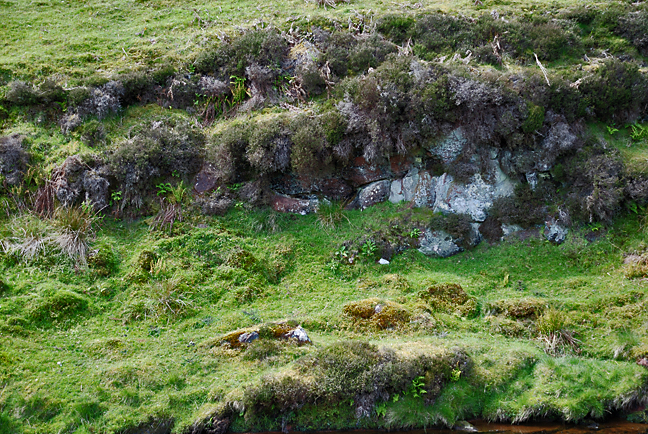All around Scotland, the land is available to walk through (for the most part), as long as one keeps the gates closed and watches out for the bulls! There are also trails (like this one to the grave) marked by the ScotWays people. Their signposting is of immense help, especially on land that a farmer isn't too keen on people walking through. Sometime the signs disappear, or are pointing the wrong way.
This area is completely different than where we have been in Yorkshire. There aren't a whole lot of fences there because the land is used mostly for crops, and not for sheep or cows like in this part of Scotland. Here there are fences all over the place (some electric). So occasionally, one must hop over, or go through, the gates to get where one wants to go. And where we wanted to go today was:
The Covenanter's Grave
The Covenanters were those people in Scotland who signed the National Covenant in 1638 to confirm their opposition to the interference by the Stuart kings in the affairs of the Presbyterian Church of Scotland.
The Stuart kings harbored the belief of the Divine Right of the Monarch. Not only did they believe that God wished them to be the infallible rulers of their kingdom - they also believed that they were the spiritual heads of the Church of Scotland. This latter belief could not be accepted by the Scots. No man, not even a king, could be spiritual head of their church. Only Jesus Christ, they said, could be spiritual head of a Christian church.
In the 17th century, the Covenanters had to seek safety in the hills. Restrictions placed on them by Charles II forced many ministers and their congregations out of their churches and onto the hills to hold services according to their conscience. These prayer meetings were known as conventicles - and attendance at them could mean death.
In 1666, a Covenanting army marched along to Edinburgh, but there they found little support. On their return, they encountered a government army of 3000 men, commanded by General Tam Dayell, on November 28, 1666, at Rullion Green. The amateur Covenanting army of 1000 was routed and scattered.
In the aftermath of the battle, hundreds of Covenanters sought refuge on the bare moor, desperate for shelter. One Covenanter sought or was offered shelter at Blackhill cottage. In 1666, shepherd Adam Sanderson lived in this lonely spot. In the evening after the battle, he met the Covenanter, John Carphin, who was clearly dying. He may have sent the Covenanter on his way for fear of arrest or his help was refused. Either way, Sanderson was aware of the man's wish to see for one last time the hills of Ayrshire. The next morning Sanderson found him dead, and at great personal risk, carried Carphin onto the open moor, and buried him there. The Ayrshire hills can be seen from his grave on a clear day.
This gate was like this when we got here!
Not sure this fence will keep the sheep in (or out).
Just before the moor started.
Heading out onto the moor.
It can get a bit wet, so we really had to watch where we were walking.
Kirsty demonstrates!
We had to walk on a lot of this bog cotton to get past some wet spots.
Grave marker in the middle of the picture.
Nov 28th 1666. A tale fit for the telling.
The view from his grave towards the Ayrshire Hills.
More sheep than people around here.
On the way back, we decided to stop and partake of the cool water.
Oh yeah, nothing like cooling off one's feet after a few hours hiking. Kirsty here is also working on her tan.
Peace to you all my friends!

















No comments:
Post a Comment